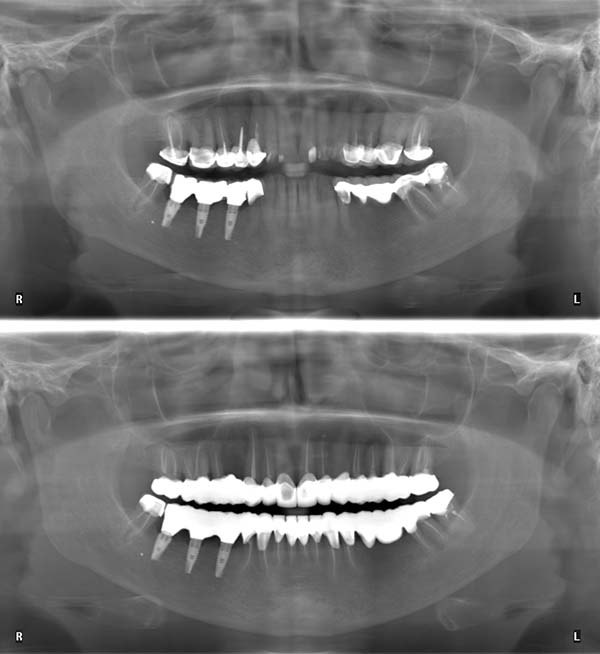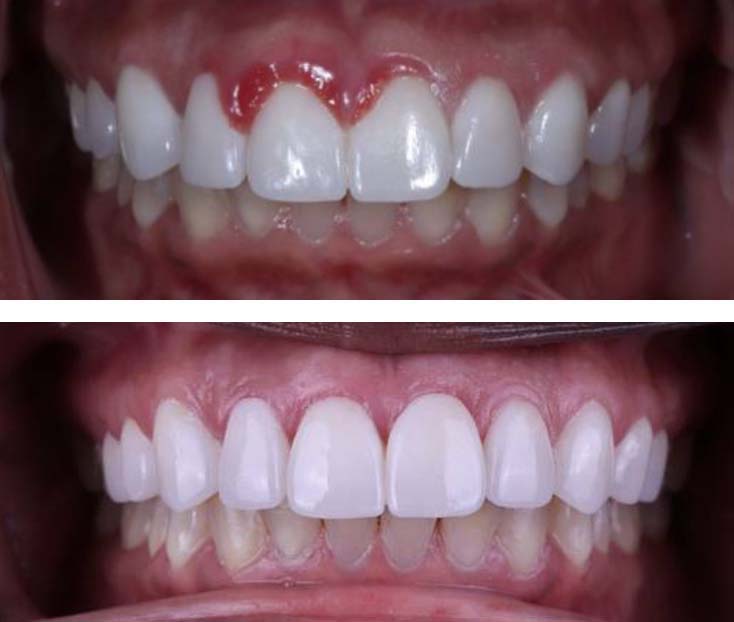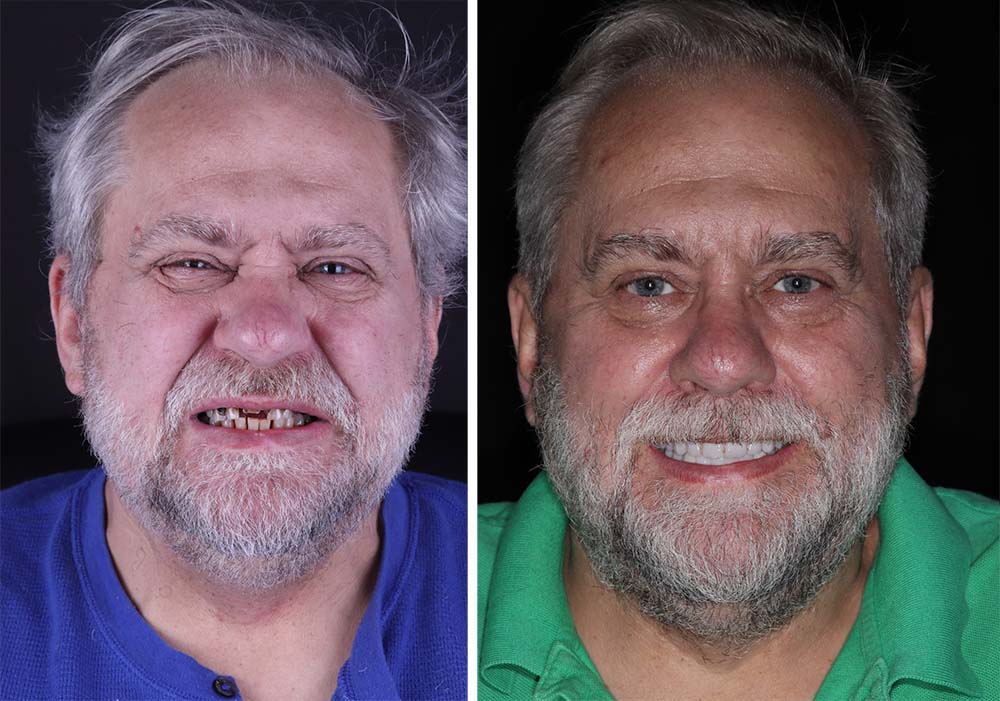Tooth Pain Under The Crown

Why does the tooth hurt under the crown? Shouldn’t it strengthen and protect the tooth tissues? We often hear patients experience toothache after receiving prosthetics in other clinics.
Discomfort can occur immediately after receiving prosthetics or a year after treatment – When should you see a doctor? How can you recognize dangerous symptoms? Is complete crown replacement necessary? In this article, we will discuss the causes and methods of treating tooth pain.
Tooth Pain Under your Newly Placed Crown
It is normal to experience tooth pain under your crown immediately after treatment, and for a short period of time after. The first 3-5 days are necessary for the tissues and mucous membrane to recover and adjust to the new restoration. The severity and duration of the pain depend on the clinical situation.
How to distinguish normal discomfort:
ncreased sensitivity. Hot or cold foods may cause sensitivity for several days after placement of new prosthetics. This is normal, but it should diminish over time. If sensitivity worsens, consult a dentist
Discomfort when closing the mouth may occur if the crown is higher than the bite. It may cause pain when chewing. It is advisable to consult a dentist for minor adjustments.
Seek dental care sooner!
We recommend seeking a dentist’s advice at the first sign of any discomfort. For mild cases, I can provide tips on reducing pain. For more complex cases, a follow-up examination and treatment are conducted. Do not perform self-treatment at home and do not delay a follow-up visit to the dentist!
Tooth Pain Under your Newly Placed Crown
Discomfort can occur after a year or more. Typically, this indicates inflammation or damage. Do not ignore these symptoms as they indicate an underlying problem. Look out for the following symptoms:
The pain intensifies and does not subside after 4 days
Pain when chewing even soft foods
Swelling or inflammation of the gums around the crown
Swelling or inflammation of the gums around the crown
Unpleasant odor or pus
Loosening or detachment of the prosthesis
Board periodontist, a specialist in full mouth reconstruction.
Pain under the crown may temporarily subside and then reappear. Do not ignore signs of inflammation. Ignoring these symptoms may lead to:
- Swelling of the gums. The cheek or palate may become swollen.
- Abscess with a fistula. Pus accumulates around the tooth and then drains into the oral cavity.
- Cyst. Forms when the periodontium is affected and leads to infection.
I recommend undergoing root canal treatment and gum therapy. Schedule an examination to preserve your teeth and prevent worsening pain.

Reasons for Pain Under the Crown
Patients often come to Dr. Tetri’s clinic with pain after prosthetics by other dentists. Typically, the treatment for these causes can be done in a single visit.
Incomplete Root Canal Filling
The dentist should treat the canals by removing the pulp and filling the cavity. The canal should be completely filled with filling material up to the root apex. If there is a 1-2 mm gap near the root apex, it can lead to infection and result in periodontitis.
It is necessary to consult a dentist who will remove the crown, treat the inflammation, re-fill the canals, and place a new prosthesis.
Nerve Pain Under The Crown
Possible causes:
Instrument fragment remaining in the canal.
Root damage (perforation), which can allow bacteria to enter through an artificial opening.
Pulp burn during tissue grinding.
“Before treatment, we conduct thorough diagnostics. The root canal treatment is performed under a microscope, which magnifies the image by tens of times. There are cases where we treat multiple teeth in a single day – below is one of them.”

The patient already had received root canal treatment of several teeth in another clinic. However, the root canal treatment was not done well. Some of the tooth canals were missed or not completely filled.
Dr. Sayin retreated almost all the canals, a total of 20 in one day.
A year has passed, and the patient comes for preventive check-ups. He is no longer bothered by dental pain.
Gum Pain Surrounding The Crown
Over time, the seal between the crown and the tooth deteriorates. Small gaps or openings form along the edges of the ceramic. Bacteria and plaque accumulate in those areas. The protruding edge of the crown can irritate the gums, leading to inflammation when brushing.

Gum problems could be the result of poor prosthetics.
The left photo shows poorly installed veneers, installed in another clinic. This led to gum inflammation. No one could help the patient.
She was fortunate to meet Dr. Tetri, a certified periodontist, who performed gum plastic surgery. The inflammation subsided, and the gum line became aesthetically pleasing. Her smile was transformed.
Recurrent caries
Secondary caries occurs due to insufficient oral hygiene. Bacteria accumulate in hard-to-reach areas. Plaque destroys tooth tissues and causes severe sensitivity. We recommend scheduling a professional cleaning to avoid risks.

The patient suffered from tooth damage for many years after receiving poor treatment in other clinics. Many teeth were missing, and the remaining ones had chips and deep untreated caries.
The treatment plan involved flying from New York to Miami for same-day teeth restoration. All the teeth were extracted, and Dr. Tetri performed a full-mouth reconstruction using dental implants.
Fracture or Cracked Tooth
A tooth or crown can crack due to trauma, bruxism, or biting on hard objects. A fracture weakens the tooth structure and causes pain when chewing or applying pressure.
Damage to the crown can result from improper fitting. Prosthesis adjustment may be necessary. In some cases, it is advisable to evaluate the position of the temporomandibular joint.
Tooth Crown Pain: What Should I Do?
In case of any tooth pain, it is essential to see a dentist on the same day. Here are a few tips:
Problem | What can be done before seeing the dentist |
|---|---|
Increased sensitivity | Use a soft toothbrush and sensitivity toothpaste. Avoid hot or cold foods |
Swollen or painful gums around the crown | Rinse your mouth with warm saltwater before your dental appointment. Gently clean your teeth, and use dental floss around the crown area |
Pain when biting down | Schedule an appointment with your dentist. Do not try to adjust the position of the prosthesis on your own |
Swelling, redness, or pus discharge | Seek immediate dental attention. Without treatment, these symptoms can lead to serious complications |
Crown displacement | If the crown is loose or has come off, do not attempt to reattach it yourself. Immediately seek dental care to have it reattached or replaced |
Dental Crown Tooth Pain: Treatment Near Me
We conduct neuromuscular diagnostics to understand the cause of tooth problems. Schedule a consultation if you experience:
- Tooth pain under the crown.
- Pain in your teeth months after dental restorations.
- Worn-out or damaged ceramic.
In our clinic, we address the underlying causes of tooth problems and provide treatment for affected teeth. After treatment, you will forget about any dental issues.

Stages of Treatment for Tooth Crown Pain
The dentist will determine possible causes of the problem, inquire about the onset and duration of the pain, and perform the following diagnostics:
- K7 Evaluation System: Neuromuscular diagnostics to assess jaw movement and bite alignment.
- Morita 3D Scanner (X-RAY): Targeted imaging of the affected area to evaluate the fit of the crown and assess tissue condition.
- 3D PIC Scanner: Highly accurate digital impression for creating new prosthetics.
Treatment of gum inflammation and other conditions. Complete oral sanitation to remove plaque buildup. Additionally, the dentist may recommend bite correction if necessary.
If an X-ray reveals a problem with the filling, the dentist will remove the crown, access and treat the root canal, remove any infection or damaged tissues, and perform canal resealing.
In case of damage or instability, a new dental crown will be fabricated. The positioning will be adjusted to avoid interference with the bite.
A follow-up examination is scheduled after 14 days of the restoration procedure. The dentist will take X-rays and assess tissue recovery. By this time, any pain should have completely subsided.
Can The Pain Be Treated Without Crown Replacement?
Yes. Depending on the clinical situation, there are three treatment methods available:
Individual mouthpieces provide better results. Their high effectiveness in eliminating uncomplicated snoring or mild/moderate apnea is clinically proven. Universal ready-made mouthpieces are less effective.
They accurately replicate the shape of the teeth. They advance the lower jaw to a certain distance to refrain from causing facial muscle hypertonicity. The adaptation period is minimal – a few days.
Neuromuscular individual mouthpieces exclude disruption of teeth alignment, facial muscle hypertonicity, and other side effects of ready-to-wear standard products. The risk of swallowing is eliminated.
Prolonged use of ready-to-wear standard mouthpieces leads to the dysfunction of the jaw joints, as well as serious dental problems.
Preventing Problems with Treated Teeth
To prevent discomfort after crown placement, follow these recommendations:
Practice individual oral hygiene at least twice a day.
Use dental floss to prevent plaque buildup between teeth.
Attend regular dental check-ups for the dentist to monitor the health of your dental arch.
Book an appointment for a Professional teeth cleaning.

